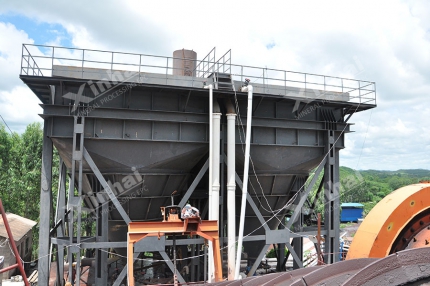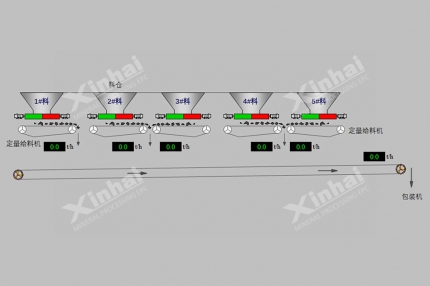Magnetite is mostly blocked granular aggregation with high magnetism and wide distribution. According to the different species of iron ore, the magnetite can be divided into single magnetite and mixed magnetite iron ore. In general, the single magnetite separation process usually adopts the weak magnetic separation process, while the polymetallic magnetite iron ore and mixed magnetite iron ore are usually separated by the combined process consisting of a variety of separation methods, including magnetic separation process, flotation process, gravity separation process, magnetization roasting magnetic separation process, reduction roasting magnetic separation process.
Use the table of contents below to navigate through the guide:
01Magnetite Separation Process
1. Single magnetite separation process
The vast majority of iron minerals in the single magnetite ore are magnetite, because the single magnetite ore has a simple composition, strong magnetism, easy to grind and easy to be separated, so the single magnetite separation process often adopts the weak magnetic separation process.

◆ When the grinding particle size is greater than 0.2mm, most magnetic separation plants usually adopt a one-stage grinding - magnetic separation process.
◆ When the grinding particle size is less than 0.2mm, the two-stage grinding-magnetic separation process is adopted us the single magnetite separation process;
◆ If the qualified tailings are separated in the rough grinding stage, the magnetite magnetic separation plants generally adopt the stage grinding-magnetic separation process;
◆ For the arid and water-deficient areas, the magnetite separation plant can use dry grinding-dry magnetic separation process;
◆ For the depleted rich magnetite iron ores or poor magnetite ores, the gangue can generally be removed by the dry magnetic separation process, and the concentrate can be obtained from the bulk rich ore by grinding and magnetic separation process.
(Magnetite separation process: stage grinding-stage magnetic separation process)
In order to obtain high-grade concentrate, magnetite concentrate can be treated by reverse flotation or high-frequency fine screen. In addition, in order to improve the recovery rate, the tailings reprocessing process can be considered to further recover the magnetic minerals.
2. Polymetallic magnetite separation process
The gangues of polymetallic magnetite often contain the silicate or carbonate minerals and are associated with cobalt pyrite, chalcopyrite and apatite, etc. Generally, the weak magnetic separation-flotation combined process is adopted as the polymetallic magnetite separation process, that is, using the weak magnetic separation process to recover the iron, and then adopting the flotation process to recover the sulfide or apatite.

In general, the weak magnetic separation-flotation combined processes used for the polymetallic magnetite can be divided into weak magnetic separation-flotation process and flotation-weak magnetic separation process. The difference of them is that the direction of the continuum of magnetite and sulfide is different. For the weak magnetic separation-flotation process, the continuous body mainly enters the iron concentrate; For the flotation-weak magnetic separation process, the continuous body mainly enters the sulfide concentrate. Therefore, under the same grinding size, the iron concentrate with low sulfide content and the sulfide concentrate with a high recovery rate can be obtained by the flotation-magnetic process.
02Magnetite – Hematite (Siderite) Separation Process
According to the types of iron-containing content, the common iron ore can be divided into magnetite, hematite, martite, v vanadium titano-magnetite, limonite and siderite ore and mixed iron ore that consists of two or more than two iron-containing content. Among them, the magnetite - hematite (siderite) is a common mixed iron ore, which is usually separated by the combined process composed of a variety of mineral processing processes.

1. Single magnetite – hematite (siderite) separation process
The iron mineral in the single magnetite - hematite (siderite) contains magnetite and hematite or siderite, most of which are fine-grained disseminated. The gangue minerals are mainly quartz, some of which contain more ferrosilite. The proportion of magnet in this ore varies and increases gradually from the surface to the deep of the deposit. Here are two magnetite separation processes commonly used for single magnetite – hematite (siderite):
◆ Weak magnetic separation-gravity separation/flotation/strong magnetic separation combined process
Adopting the weak magnetic separation to recover the magnetite, and the gravity separation, flotation or strong magnetic separation to recover the weak magnetic iron ore. The practice shows that for the weak magnetic separation-flotation process, the flotation can be placed after the weak magnetic separation according to the ore properties and the actual situation of the concentrator, so as to ensure the stability of production indicators and save costs. For the weak magnetic separation-gravity separation process, it is recommended to use the weak magnetic separation-strong magnetic separation or weak magnetic separation-strong magnetic separation-gravity separation process to get a higher separation index.

◆ Magnetization roasting magnetic separation process or the combined processes
The magnetization roasting magnetic separation process of single magnetite-hematite (siderite) is similar to that of single weak magnetic iron ore, but in the combined process of magnetization roasting magnetic separation process with other ore dressing methods, the combined process of weak magnetic separation and other ore dressing methods is often used for the powder.
2. Polymetallic magnetite – hematite (siderite) separation process
The iron minerals in the polymetallic magnetite – hematite (siderite) are mainly magnetite and hematite or siderite with medium and fine grains dissemination. The gangue minerals mainly include silicate and carbonate minerals or fluorite, and are associated with apatite, pyrite, chalcopyrite and rare earth minerals.
The polymetallic magnetite – hematite (siderite) separation process is relatively complex in the iron extraction, generally the combined process composed of weak magnetic separation and other processing methods. That is, adopting the weak magnetic separation process to recover the magnetite, then using the gravity separation and flotation or magnetic separation process to recover the weak magnetic iron ore, finally using the flotation process to recover the associated elements.

For rare earth-containing magnetite ore, the reducing roasting magnetic separation-flotation process can be used when there is a large amount of hematite in the magnetite. That is, adopting the reducing roasting magnetic separation to extract the iron ore, and the floating the rare earth minerals after the reducing roasting, which greatly improves the separation index.
The above are the common magnetite separation processes. Due to the different species of magnetite ore, most magnetite concentrators will adopt the combined process consisting of multiple beneficiation methods. Therefore, for the magnetite separation, it is suggested to develop a suitable technological process according to the mineral processing test, and rationally choose an appropriate magnetite separation process according to the final test report.


 marketing@ytxinhai.com
marketing@ytxinhai.com  0086 13810327080
0086 13810327080 






































































































 CHAT
CHAT MESSAGE
MESSAGE









